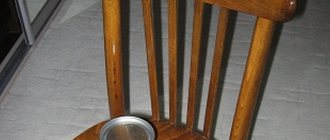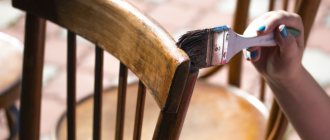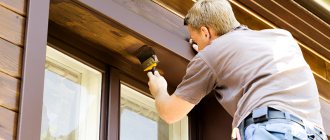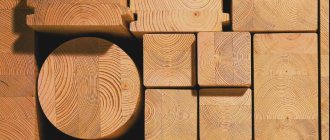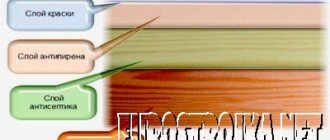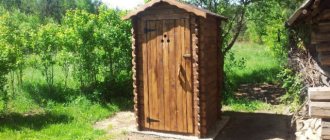The best manufacturers produce wood varnishes for interior and exterior use, which are designed to protect wood from negative factors. When applied, a thin transparent protective film is formed. You can apply one layer or several. At the same time, the aesthetic appearance and decorativeness of the tree increases. When choosing a substance, it is necessary to analyze the conditions under which the wood will be used. An incorrectly selected composition can lead to negative consequences.
Types of wood varnishes
Manufacturers are ready to provide protective materials to suit every taste.
They can be:
- One and two-component. The first compositions are already completely ready for use (home craftsmen prefer them), the second ones will have to be mixed independently, focusing on the manufacturer’s instructions and one’s own preferences. But they are more durable and are often preferred by professional finishers.
- Matte and glossy.
- Transparent and tonal. The second option will allow you to make an imitation of a more expensive material from ordinary wood.
All these characteristics can be assessed immediately before purchasing, but it is better to find out the pros and cons of each type of varnish at the stage of planning the purchase.
Why do bubbles appear?
There are several options for this behavior of varnish:
- High wood humidity;
- There is a lot of varnish that is not distributed during application;
- An inappropriate application method was used;
- Poor compatibility of the varnish with previously applied compounds;
- Poorly polished surface;
- If a two-component formulation is used, a poorly mixed mixture may cause bubbling;
- The previous layer has not dried;
- There is dust or dirt left on the surface.
There are different reasons. Even a seemingly trifle in the work can ruin the final result.
Features of varnishes
When choosing a future coating, pay special attention to:
- Conditions for future use. For items that are intensively exposed to ultraviolet radiation, rain, snow, wind, and temperature changes, practical and durable materials for outdoor use are selected. Its less durable brother will perfectly decorate furniture and interior decoration.
- Wear resistance. To decorate surfaces that are subject to severe abrasion (for example, floors), choose a varnish with the maximum level of wear resistance; for finishing decorative elements you can use the simplest varnish.
- Toxicity. Due to their structure, all varnishes have a strong aroma, but some materials stop emitting an odor quite quickly, while some are ready to smell for weeks, and the concentration of hazardous substances during application is very high for some materials. If it is not possible to arrange high-quality ventilation or close the room until the applied coating has completely dried, then it is better to use water-based products, but if it is possible to use protective agents and leave the wood to dry in splendid isolation, then you can use both hydrovarnishes and a polyester compound.
- Drying time. Water- and oil-based varnishes take the longest to dry, and therefore they are used if there is no urgent need to use varnished items in the coming days (weeks). Alcohol varnishes will acquire the necessary strength within half an hour.
- Temperature resistance. To decorate rooms where there is a high risk of fire and increased temperature, heat-resistant varnishes are purchased.
- The need for a primer. Self-priming varnishes do not require prior application of adhesives; all other materials are applied over a primer layer. Otherwise, the varnish may crack or begin to peel off.
Why varnish products
Many types of needlework suggest coating the product with varnish at the final stage of production. The importance of this procedure is difficult to overestimate. Varnishing performs a number of important functions:
- Gives the work a finished look. Moreover, varnish coating can hide defects and flaws made during the work process.
- Protects the surface from the adverse effects of environmental factors (temperature changes, humidity, dust, dirt, etc.). The varnished surface is more resistant to scratches, fading in the sun or swelling due to moisture. The protective film that the varnish forms prevents the material from deteriorating.
- Has a decorative effect. Modern varnishes can not only emphasize the brightness of colors and give a noble shine to your painting, box, figurine or any other product, but can also have various decorative properties - an aging effect, contain glitter or make the surface velvety to the touch. If we are talking about painting, then varnish emphasizes the small details of the drawing, making the picture more voluminous.
Types of varnishes for wood
There are about ten types of varnishes suitable for decorating wooden structures. They are divided according to the type of solvent, so they have completely different performance qualities.
Services of professional finishers
offers its services for painting and varnishing the facade of a wooden house. We have specialized in finishing timber and log houses for more than ten years. The qualified craftsmen of our company have extensive experience working with wood.
We use certified paints and varnishes from well-known manufacturers, which are of high quality and safety. We are ready to perform any amount of work, from local painting to turnkey home finishing.
You can leave your requests in any convenient way using the coordinates in the “Contacts” section.
Calculate the cost of painting and insulating your home right now
Select types of work:
Select materials:
Oil varnishes
These preparations are based on natural oils and resins. Despite such a pleasant neighborhood, this species is not very popular due to its high cost. Although now natural ingredients are increasingly being replaced by artificial compounds, which leads to lower prices.
Oil-based varnishes have proven themselves to be excellent when decorating floors, but you will have to wait 1-3 days for the surface to dry.
comparison table
Based on the rating compiled above, we organized the main technical parameters of varnishes and placed them in a table. With this organized information, you can track down the most suitable remedy for yourself.
| Name | Shine | The basis | Weight | Price, rub) |
| EUROTEX | semi-gloss | acrylic | 2.5 | 400 – 850 |
| TEX Pro | glossy | acrylic | 2.5 | 650 – 1 200 |
| VGT | glossy | acrylic | 3 | 350 – 700 |
| Dulux Diamond Glaze | glossy | acrylic-urethane | 0.9 | 480 – 650 |
| Tikkurila | glossy | acrylic | 2.7 | 500 – 680 |
| Parade | glossy | acrylic | 2.6 | 800 – 1 100 |
| Dulux | semi-gloss | alkyd-urethane | 2.5 | 400 – 600 |
This is interesting: How to choose a wear-resistant and moisture-resistant floor varnish - we explain carefully
Alkyd varnishes
To create these paints and varnishes, synthetic resins, solvents, and substances that increase the drying speed are used.
The advantages of this segment of coatings are:
- Resistance to all unpleasant living conditions (some of these varnishes can withstand even sunlight and are not afraid of fire);
- High wear resistance;
- Long shelf life;
- Loyal cost.
Similar paints and varnishes are used to decorate floors, including heated floors, and to decorate furniture sets and individual items.
You will have to wait for final drying for 2-3 days, and the varnish will emit a very unpleasant odor.
What to do before painting
Painting wooden facades should be done only after some preparatory measures have been completed.
You also need to consider the following points in advance:
- All wood surfaces must be inspected for imperfections. If the latter are identified, then they need to be eliminated by repair or replacement of parts with new ones;
- carefully read the instructions before the first problems arise;
- check the surface for dryness. Also, the temperature of all materials and air should not be below 5 degrees Celsius. Air humidity should not exceed 80%;
Prepared surface of the external walls of the house for priming and further work
If the paint is oil-based, then you do not need to apply it in the evening, since the surface will be exposed to dew. When working in bright sunshine, the surface to be painted must be protected from direct sunlight (during the painting period); instead of colorless antiseptics, it is better to choose colored ones - they will better protect the facade from ultraviolet radiation; primer and paint must be the same color; If there are places on the surfaces covered with mold, then they need to be washed with a solution of “Homeenpoisto” and water in a ratio of 1 to 3. This solution is applied from the bottom up. After use, the solution is washed off with water using brush movements from top to bottom; the above-mentioned composition lightens the wood, so you need to make sure that it does not get on unpainted surfaces;
Homeenpoisto solution for removing mold from wooden surfaces
primer antiseptics are applied to new logs and boards as quickly as possible
If painting work is planned to be carried out only for the next season, then you can protect the tree from biological influences using two layers of Valtti-Pohjuste antiseptic; if glazing antiseptics are used, it is important to remember that the final color will also be influenced by the type of wood, as well as the number of layers applied. A test application of paint is used to check the color; antiseptics are applied along the wood fibers from edge to edge and without stopping; Mixing the paint is done once and in one container - otherwise the shades of colors may differ.
Painting wooden houses also requires observing certain things during the process:
- the ends of the wood are also treated with a primer and paint layer - this is necessary to protect them from moisture;
- the final color will be clear only after drying - therefore, when trying the paint, you should wait until it dries;
- the paint must be mixed before and after the painting process;
- For temporary storage, it is best to place the brush in a tightly tied plastic bag.
After finishing painting the facades, you should close the jar so that the lid fits completely into it. After this, the jar is turned upside down for a while. This way the lid will close more tightly.
If after completing all the work there is still paint left and no longer planned to be used, it is recommended to transfer it to a toxic waste collection site.
Alkyd-urea varnishes
The two-component material hardens using special hardeners. But this composition will be good for only a few hours, so it’s quite difficult to guess the size of each portion.
The varnish perfectly protects objects from water and is able to withstand high loads.
It is usually used to design:
- Sexes;
- Wall panels;
- Furniture;
- Decorative elements located indoors.
Review of manufacturers and prices
To help decide on the choice of material, you need to have an idea of the range of products.
To help decide on the choice of material, it is worth reading not only reviews from craftsmen and buyers, but also a rough idea of the range of paint and varnish products from popular manufacturers.
- Parquet varnishes: Bona, Berger-Seidle, Loadur are considered the best. Price from $150 per 1 kg;
- Alkyd varnishes: PF-231, MCh-0163, EP-2146. These are Russian products that are distinguished by their versatility and ease of application. It is worth remembering that there is a strong odor, and also preview customer reviews; in particular, MCh-0163 has little resistance to UV rays, so use in sunny rooms is not indicated. Price from $30 per 1 kg;
- Yacht varnishes: Poli-R, Novbytkhim, Prestige, Eurotex. The price of goods varies depending on the composition, the presence of gloss and other nuances, but all the presented manufacturers offer products that are certified and as environmentally friendly as possible. The assortment is quite wide, so each buyer will be able to choose the composition based on their own preferences. Price minimum $40 for 1.9 liters, maximum price $65 for 1 liter.
As for other types of varnish: oil, nitro, acrylic, they can be found both from the listed manufacturers and by looking at the catalogs of offers on the company’s websites. Remember that you need to choose the composition only after you have determined which floor will be covered: oak, larch, alder or pine parquet, and also taking into account the traffic flow of the room, humidity and other factors.
Nitrocellulose varnishes
The paintwork materials of this group include:
- Artificial resin;
- Plasticizer;
- Organic solvent;
- Cellulose nitrate.
Varnish is popular for finishing interior surfaces due to:
- Quick drying;
- Possibility of further polishing;
- High decorative properties;
- Deep penetration into the layers of wood.
Among the disadvantages, the following stand out:
- The need for protective equipment;
- Strong smell.
Let's sum it up
You cannot use regular varnishes on outdoor products. And from this article we learned why. It is not for nothing that special compounds were created for this purpose. They have excellent characteristics and can serve in negative conditions. All that remains is to decide on the type of paintwork and buy it. And thanks to a video about each type of coating, you can easily do it yourself.
Recommended Posts
Oil paints.
Characteristics How to paint walls with water-based paint without streaks
Silver paint
Mixing colors
Coal solvent
How to choose washable paint for the kitchen
Polyurethane varnishes
These varnishes have maximum durability and are therefore considered a universal finish.
The advantages of this group were:
- Excellent performance properties;
- Easy penetration into layers of wood;
- High drying speed.
The varnish is great for decorating exterior surfaces and interior decoration.
The disadvantages of these varnishes are the price and the need to strictly follow the manufacturer's instructions.
How to choose the right decorative plaster for the facade
Before choosing one option or another, you need to consider the following parameters:
- Flexural compression and strength characteristics. The ability of the decorative material to fight the formation of cracks depends on them. Under heavy loads, the plaster on the surface will not collapse.
- Color of decorative material. There are products on sale that are already painted in a certain shade. This is Ceresit plaster. But, there are basic white compositions that need to be tinted at the mixing stage. This is a better option than painting over an already applied surface after drying. After all, the paint layer is thin and if damaged, the base color of the decorative plaster will be visible. And if you tint it, the shade will be throughout the entire structure of the material.
- Texture. Decorative material has different textures, which creates an imitation of different surfaces and materials (stone, wood), as well as relief (fur coat, mosaic surface, bark beetle). The packaging indicates what decorative texture will be obtained after application.
- The basis. Having compared all the advantages and disadvantages of the types of decorative products, you need to choose the best one for yourself.
- Drying. Depending on the type, from 1 to 3 days.
- Layer thickness (maximum and minimum). For wood, brick or concrete, decorative plaster is needed for exterior finishing of walls of different thicknesses.
- Shelf life of the finished mixture. For beginners, an important indicator is that the longer the period, the longer he can apply the prepared composition.
No less important are consumption, frost resistance, adhesion to the surface and method of application (manual or mechanical).
Water-based acrylic varnishes
This category of varnishes is considered to be the most environmentally friendly paints and varnishes. The material does not emit odors and is completely safe, therefore it is used even when decorating children's rooms.
The disadvantage of varnish is that it takes a long time for surfaces to dry:
- The varnish will finally harden a couple of weeks after application.
- In addition, it is not very suitable for outdoor use, not providing the required level of moisture resistance.
- And in terms of abrasion resistance, the varnish has not proven itself very well.
Useful tips
- Self-adhesive film is used to protect windows from splashes. You need to remove it after application, without waiting for the paint to dry.
- Paint stains from windows can be removed with a dry cloth previously moistened with white spirit. Traces need to be removed after the paint has partially dried - the main thing is not to let the paint harden, but there is no need to remove fresh paint either, since it will begin to smudge.
- The quality of painting also depends on the choice of a good brush. To paint small details, use a pointed brush.
Painting work is not recommended to be carried out under the scorching sun
If painting a plank surface, take breaks only after finishing painting the last board. It’s better to paint everything in one go. Before finishing, it is advisable to smear the edges with weak strokes of a dry brush. When applying paint to elements of windows and doors, the problem arises that the paint will stick together. You can avoid this by painting early in the morning so that by evening the surface is dry and you can start using the doors and windows. It is advisable to lubricate the hinges with Vaseline - this will prevent difficulties with opening the next day. To prevent sand particles from the walls from getting into the paint container, pour the required amount into a separate container.
Epoxy varnishes
These materials were developed based on epoxy resins and differ:
- High strength;
- Hardness;
- Wear resistance to abrasion and mechanical damage.
The material will be an excellent option for finishing interior spaces, including floors; it also serves well for exterior decoration.
Classification by place of application
Based on the place of application, two categories can be distinguished:
- External;
- Internal.
But it can also be divided according to a narrower purpose:
- Parquet.
- Furniture.
- For street work.
Polyester varnishes
The varnish will be an excellent coating for finishing floors, furniture and even musical instruments.
But working with this material is quite difficult: It requires special equipment and professional skills.
Advantages of lacquered furniture
- Natural wood in its entirety is not only associated with ecology, but also looks attractive in any interior, no matter what style you choose. Varnishing - whether glossy or matte - gives the wood a touch of sophistication, nobility and some monumentality.
- The varnished surface is incredibly easy to clean, because any stains and fingerprints are erased in a second.
- In addition to external advantages, lacquered furniture is reliably protected from dirt, dust and moisture, as well as from accidental mechanical damage.
- One of the main advantages is the ease of restoration: there are special care products that we will look at a little later.
Water-based polyurethane varnishes
Such materials have become an improved copy of acrylic varnish.
They are characterized by:
- Resilience;
- Elasticity;
- Durability;
- Environmentally friendly;
- Durability.
The only downside will be the high price of the material.
Alcohol varnishes
Such coatings are made on the basis of ethyl alcohol. Thanks to the rapid evaporation of the volatile substance, the varnish dries almost instantly: the maximum period is only an hour.
The advantage of this material is its light shine, the disadvantage is poor resistance to water and damage. Most often, such varnishes are used for the final finishing of musical instruments and furniture structures.
A variety of varnishing materials will help create a durable and beautiful coating that will suit all the needs of future owners.
Plastering technology for creating decorative surfaces
There are a huge variety of styles of material application. There are complex techniques where working alone is simply unacceptable.
Complex Travertino technique
Let's talk about the most common technologies:
- "fur coat";
- "bark beetle";
- "mosaic".
They will certainly decorate the facade of your home and make it unique.
"Fur coat"
“Fur coat” is a variant of interior and exterior wall decoration with a rough surface. To do this, you do not need to look for specialized material; the effect is achieved through a unique application.
Options for applying a “fur coat”
Covering the wall is not difficult, so this option is great for DIY application. The layer turns out dense and thick, it serves as additional sound insulation for the house. For the “fur coat”, they often use not ready-made solutions, but self-made ones based on cement and sand.
Let's talk about four options for applying such a decorative layer:
- Using a roller with holes or made of fur. For this, a liquid solution is used. If it seems thick, it is diluted with water or another product. The mixture is applied to the wall with a spatula, and then it is rolled out over the surface using a roller.
- Using a spatula, apply the mixture to the wall, smooth it out, and then use a trowel to create a texture. This method is the simplest and can be used by beginners. To create the design, apply a trowel to the wall while the plaster is wet, and then quickly remove it. You will get a “fur coat”.
- You can also create a pattern using a special sprinkler. It is very convenient to work using mechanical means.
- The last option is to imitate the design using a broom. A new one is sprayed onto the applied thin smooth layer by sharp swings of a broom, previously lowered into a bucket of solution.
Creating texture using a fur roller
"Bark beetle"
Perhaps the most popular type of solution application. Externally, the surface resembles wood eaten away by beetles, hence the name.
Surface "bark beetle"
For such work, specialized ready-made solutions, as well as dry mixtures, are offered. First, a smooth layer of plaster is applied. As soon as it starts to dry out and stops shining, start rubbing it with a trowel. The design options “rain”, “lamb”, “carpet” depend on how the hand movements are made (horizontally, vertically, diagonally, in a circle).
The wall is made using the “bark beetle-rain” technique
A short video will help you decide on the technique:
Related article:
Mosaic
This option looks very impressive, and came to us from antiquity. The material contains marble, malachite, lapis lazuli chips, fractions up to 3 mm in size.
"Mosaic" option
The application technique is simple: using a grater, the mixture is pulled from one corner to another without drying out. You need to work quickly so that the joints are not visible.
